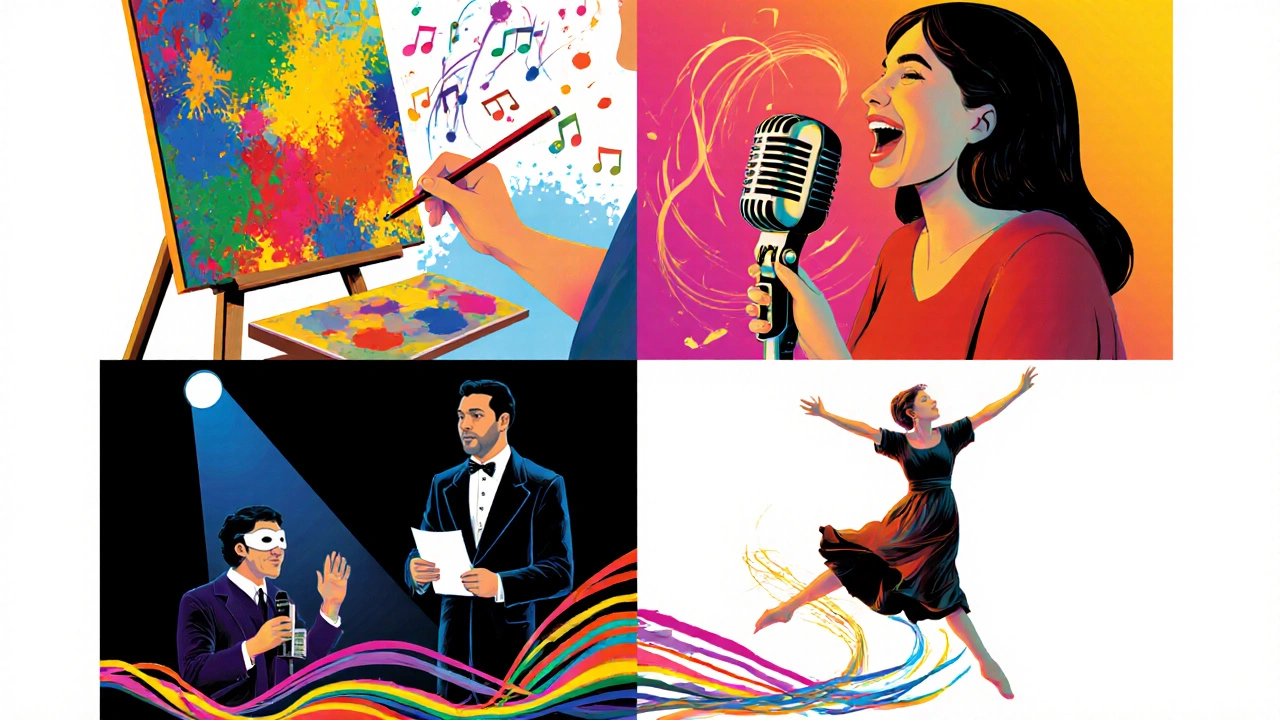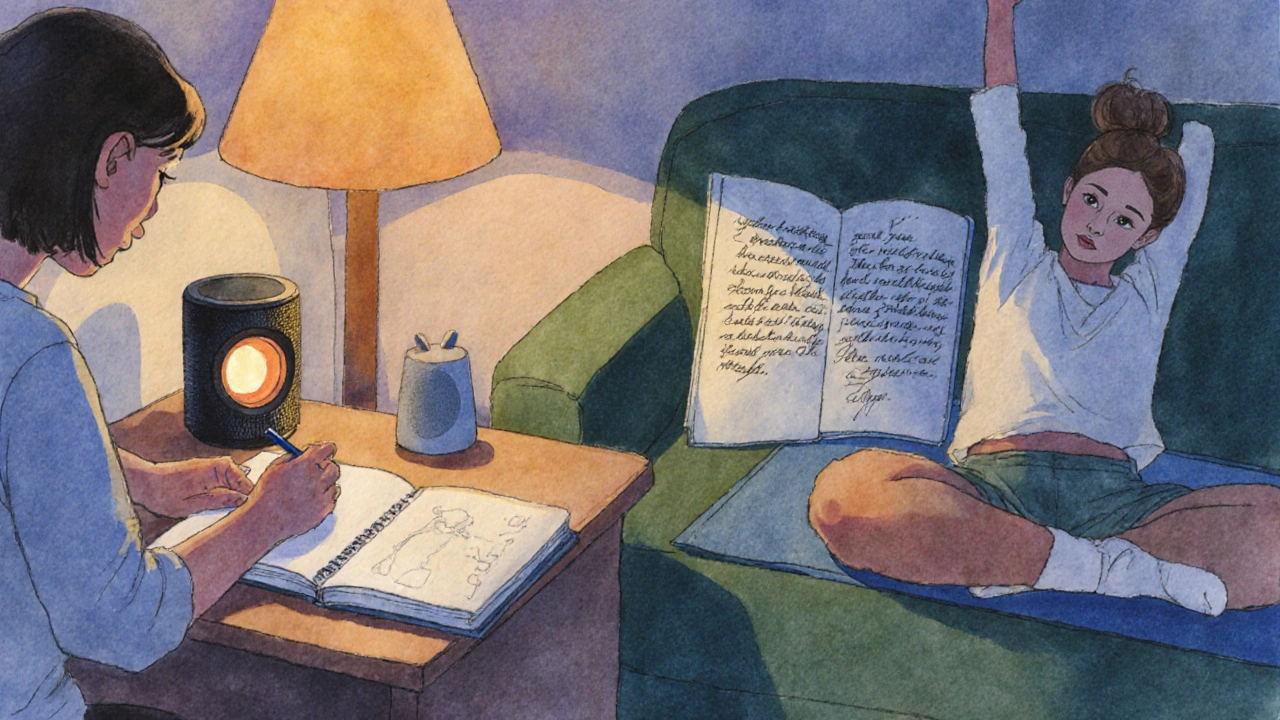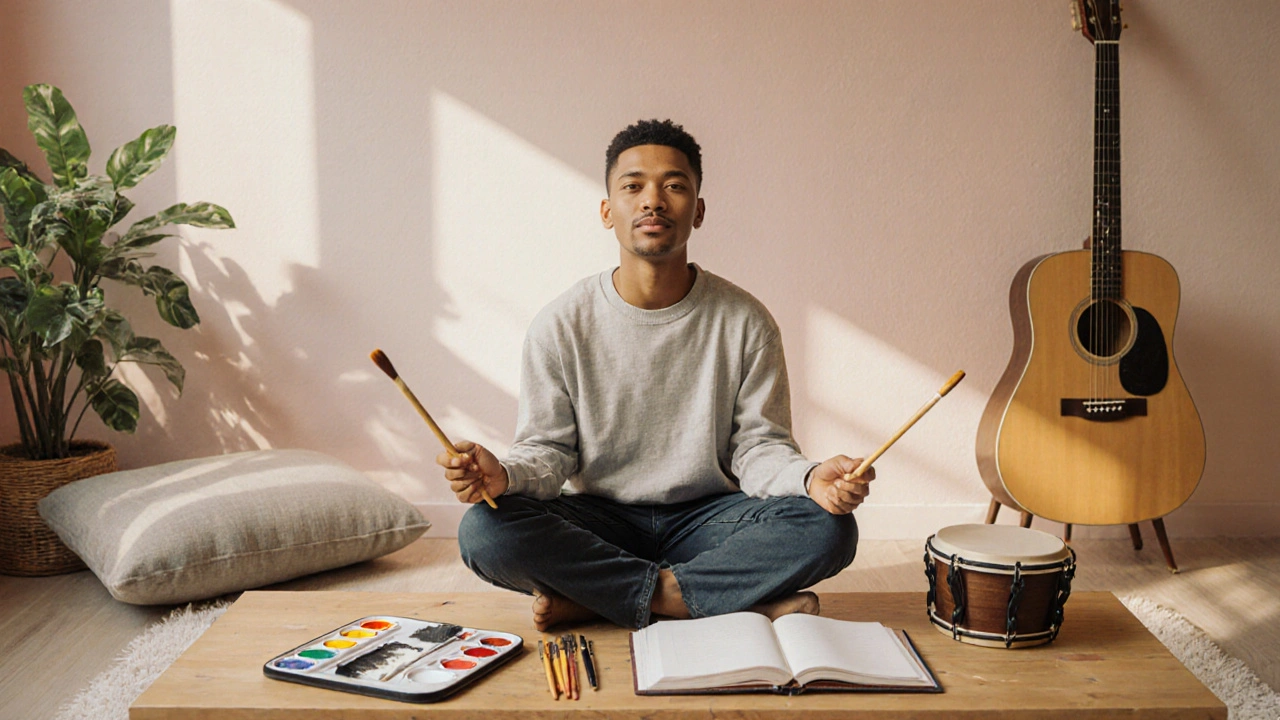Creative Arts Therapy Selector
When it comes to healing feelings, Creative Arts Therapies is a set of therapeutic approaches that use artistic expression-visual art, music, drama, dance, and writing-to help people process emotions, reduce stress, and build resilience. Practitioners often call it Expressive Arts Therapy. If you’ve ever felt stuck after a rough day, a paint‑splash or a drumbeat can feel like a secret door to a calmer mind.
Why the Arts Feel Like Medicine
Science shows that creative activities light up the brain regions linked to reward, memory, and emotion regulation. When you draw, the visual cortex talks to the limbic system; when you sing, the auditory pathways sync with breathing patterns, calming the nervous system. This mind‑body feedback loop is why many clients report instant relief after just a few minutes of doodling or humming.
Key Modalities in Creative Arts Therapies
- Art Therapy: Uses drawing, painting, sculpture, or collage to explore inner experiences.
- Music Therapy: Employs singing, instrument playing, or guided listening to shift mood and improve communication.
- Drama Therapy: Leverages role‑play, storytelling, and improvisation to rehearse new ways of being.
- Dance/Movement Therapy: Uses body movement to release tension and express feelings that words can’t capture.
- Expressive Writing: Guides clients to write freely about traumatic or stressful events, turning chaos into narrative.
How Each Modality Supports Emotional Healing
Below is a quick snapshot of what you can expect from each approach.
| Therapy | Primary Modality | Typical Session Length | Main Benefits | Common Conditions Treated |
|---|---|---|---|---|
| Art Therapy | Visual creation (painting, drawing) | 45‑60 mins | Improves self‑awareness, reduces anxiety | Depression, trauma, chronic pain |
| Music Therapy | Listening, instrument play, vocalization | 30‑60 mins | Elevates mood, enhances social connection | ADHD, PTSD, dementia |
| Drama Therapy | Role‑play, storytelling, improvisation | 60‑90 mins | Builds coping narratives, improves communication | Borderline personality, eating disorders |
| Dance/Movement Therapy | Guided movement, choreography | 45‑75 mins | Reduces somatic tension, boosts body confidence | Trauma, anxiety, motor disorders |
| Expressive Writing | Free‑form journaling, structured prompts | 20‑30 mins | Clarifies thoughts, lowers stress hormones | Grief, chronic illness, career burnout |

Getting Started: Finding the Right Therapist
In Australia, most creative arts therapists are accredited by the Australian Association of Creative Arts Therapists (AACAT). Look for the AACAT credential on a practitioner’s website, and ask about their training in your specific modality.
- Check professional registration: AACAT membership ensures ethical practice.
- Match the therapist’s specialty to your goal-if you’re dealing with grief, art or expressive writing may fit best.
- Schedule a brief consultation (often free) to discuss comfort level, session format, and fees.
- Consider location and availability; many Brisbane therapists now offer hybrid (in‑person + telehealth) sessions.
Don’t hesitate to ask about their approach to confidentiality and how they integrate traditional psychotherapy if you’re already seeing a psychologist.
DIY Creative Healing at Home
You don’t always need a paid therapist to reap benefits. Here are three low‑cost practices you can start tonight:
- Mini‑Art Prompt: Grab a pen and a piece of paper. Sketch anything that comes to mind for five minutes-no judgment, no erasing.
- Feel‑Good Playlist: Compile ten songs that make you smile. Play them while you do a simple stretch routine; notice how your breathing changes.
- Story‑Swap Journaling: Write a short story where you are the hero overcoming a current challenge. Read it aloud and imagine the next step you’d take.
Even a single session of these activities can lower cortisol, the stress hormone, and give you a fresh perspective.
Evidence Supporting Creative Arts Therapies
Recent meta‑analyses (2023‑2024) show statistically significant reductions in anxiety scores for participants in music and art therapy programs. A 2024 Australian study of 312 veterans found that a 12‑week dance/movement program cut PTSD symptom severity by 38%. These outcomes are not magic- they work best when combined with conventional talk therapy and a supportive environment.

Common Pitfalls and How to Avoid Them
- Expecting Immediate Mastery: You don’t need to be a painter to benefit. Focus on process, not product.
- Skipping the Warm‑up: Jumping straight into deep expression can feel overwhelming. Begin with a grounding exercise (e.g., five deep breaths).
- Choosing the Wrong Modality: If you’re uncomfortable moving your body, dance therapy may feel stressful. Try a quieter modality first.
- Neglecting Therapist Guidance: Self‑guided work is helpful, but a qualified therapist can point out hidden patterns you might miss.
Putting It All Together: A Simple Weekly Plan
Here’s a sample schedule that blends two modalities and a self‑practice routine:
- Monday - 30‑minute expressive writing session (focus on a recent stressor).
- Wednesday - 45‑minute art therapy with a licensed therapist (bring a sketchbook).
- Friday - 20‑minute feel‑good music listening while doing gentle stretches.
- Saturday - Free‑form painting at home, no pressure, just colors.
Adjust the timing to fit your life, but try to keep a rhythm. Consistency reinforces the neural pathways that support emotional regulation.
Next Steps for Readers
If you’re ready to explore further, start by searching “AACAT therapist Brisbane” and bookmark two profiles that mention your preferred modality. Book a short intro call, and bring a list of goals you hope to achieve. Remember, the creative process is a partnership-your therapist guides, you create.
Can creative arts therapies replace traditional psychotherapy?
They complement, not replace, traditional talk therapy. Creative modalities target the body‑mind connection, while psychotherapy often focuses on cognition and insight. Many clinicians integrate both for a fuller healing experience.
Do I need any artistic skill to start?
No. The goal is expression, not mastery. Therapists emphasize “process over product,” so a beginner is welcome.
Are these therapies covered by Medicare in Australia?
Some private health funds reimburse accredited creative arts therapy sessions, but Medicare generally does not. Check your policy or ask the therapist about bulk‑billing options.
How long does it take to see results?
Clients often notice a mood lift after a single session, but measurable reductions in anxiety or PTSD symptoms typically emerge after 8‑12 weeks of regular work.
Can I combine more than one modality?
Yes. Many therapists blend art and music, or add movement to a writing practice. The key is to keep the focus clear for each session.





